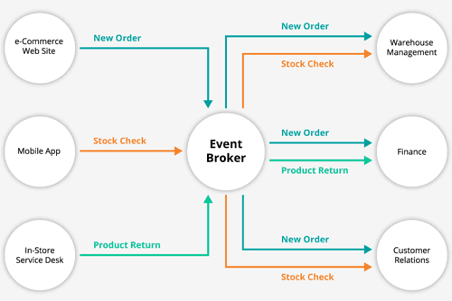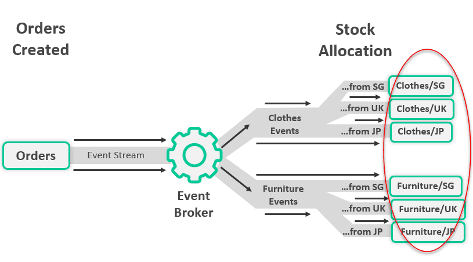In today’s omni-channel retail landscape, competition is more intense than ever and retailers are using technology in ways not before possible. With the ubiquity of cloud services, those most aggressively pursuing integrated digital strategies are winning over the customer. Information is uniquely powerful because unlike shelf space or delivery trucks, you can use it any number of times and ways. Unfortunately, many retailers still exchange data between systems with antiquated point-to-point interfaces because migrating from this approach can be complicated. Doing so makes it really difficult to distribute information across their enterprise and reuse it as part of new processes, to fuel analytics engines and decision support tools, and to reuse it in new and interesting ways.
Subscribe to Our Blog
Get the latest trends, solutions, and insights into the event-driven future every week.
Thanks for subscribing.
Before I joined Solace, I worked for Europe’s largest retailer, the Schwarz group, which operates Kaufland and Lidl supermarkets, for 11 years. I worked as a leader for the integration platform team and lastly as a product owner for event streaming and messaging, where my last project was one of the most exciting – I was part of the team that migrated the Schwarz messaging platform (1 billion messages/day) to Solace Platform to build an event mesh that could stream data across a hybrid- and multi-cloud environment in such a way that it could be sent to and reused by countless systems across their organization in an event-driven manner. (Note that in the worlds of event-driven architecture (EDA) and event streaming, we refer to event-driven information as “events” – I’ll explain more below…
In this post, I’ll explain why it’s so important for retailers to make the most of their in-store, online and supply channel events, and how Solace’s smart topics make it easy to maximize event reuse through hierarchy and wildcards. I’ll then show how it all comes together by sharing what Schwarz has achieved.
Events 101
Anything that happens within a retail business can be considered an event – a customer checking out at a register, a high temperature detected in a warehouse, a delivery truck getting a flat tire, etc. They all have the potential to affect your business to some degree, and some have ripple effects that impact many processes and people. That’s why it’s important to make sure applications and people know about them, so they can react to them. Say you want to update your inventory when a customer buys a product – very typical use case for an event which is coming into the inventory system. As uses for this information become more complex, these events can have a global impact across diverse technologies.
Types of Events
There are several different kinds of events:
- Notification Only: The one everybody knows is the notification only: “hey, something changed.” You might get a business object key, but you don’t have the data in the event and you don’t have the metadata, so you have to call back to the source system to get the data. An example would be that a customer’s contact info changed, but you don’t even know it was the street address, specifically.
- Notification with Metadata: In this case, you know, what changed. So for example, you know the customer’s street address changed, but you don’t know what it changed to. Again, you need a call back scenario. This gives you tight control of content if you want to have this in place.
- Notification with Data: Most common in retail enterprise application use cases, in this case, you’ll get the actual data that changed: the address, the street…everything you need to know to be able to react on this event.
- Command: There’s a fourth type of event which all of you using async API are aware of. It’s the command event. In this case, you can send an event to a system and the event is doing something with it based on your command.
You’ll end up selecting and combining these types of events depending on your use case. This diagram shows three event producers (a web site, mobile app and point-of-sale system) and the different events they produce (an order, a customer query and a product return).
What’s Driving the Need for Events
- Cost Savings: Retailers need to be more efficient across the board, including within internal processes and how they do, for example, integration.
- Importance of Innovation: They need to overcome new challenges associated with building new offerings like BOPIS/BORIS, e-couponing and loyalty programs to stay competitive.
- Commitment to Omni-Channel: Covid changed buying behavior forever; customers now buy in a way that requires the combination of, and coordination between, online and physical stores.
- Customer Experience Expectations: Switched-on retailers are using hyper-personalization to the max, meeting customers where they are, and anticipating their next move by leveraging behavior events and incorporating new technologies such as AI and ML.
Events in Retail
I’ve been talking a lot about events and reusability, but what are the events coursing through major retailers?
Supply Chain Events: Logistics and Production/Disposition
I want to showcase how many business processes are empowered by events at larger retailers. So let’s start at the bottom — supply chain management, which is full of event-driven use cases. Think about route planning that could be modified in response to equipment failures or traffic congestion, or stock metrics which need to be accurate so that the customer knows things are definitely available for purchase.
Getting Product and Data To, Into and Out of Stores
Looking at the store layer, there are many use cases related to the processes of getting products to the store, into the store and out of the store – many of which revolve around events. Just think about sending product master data to your point of sale systems, even sales data, which is being sent out of the store and needs to be reused by many different systems.
Business Operations Efficiencies
There are many processes that revolve around events in corporate headquarters. For example, within recruitment, where each employee’s journey from “hired to retired” is full of synchronous events. So too are customer-facing processes related to e-couponing and loyalty programs. Finance is a big ‘event’ producer too, as it’s tied into all those different business processes I just described.
Below is an example of some of the most common use cases in retail today that are leveraging EDA.
The Importance of Smart Topics
To make sure all kinds of systems can get the events they need, and take action, you need to make sure events are described in a way that’s easy to understand and subscribe to. Thats’ where topics — specifically smart topics — come in.
Solace smart topics are part of the event itself, making them a powerful tool in the hands of a well-architected EDA environment. As you can see in the diagram below, Solace topics aren’t objects on the broker, which you might expect because you know it from your experience with other solutions. A topic in Solace is just a string that’s part of the event, and you can use hierarchy to put in many different properties, to use for routing, filtering, and for reusing your events. Topics can be up to 250 bytes, with up to 128 levels of hierarchy to describe your event in an extremely detailed, granular way. It means that organizations can create well-defined topic structures and hierarchies that can deliver a lot of capability without driving up cost and complexity.
I like to compare Solace topics with hashtags in social media. So you put just as many hashtags on your event as you need to ensure other systems can get the relevant data they need. They need to, they need to receive. So what could you do with this?
Here’s an example that showcases which routing capabilities and reusing capabilities these topics can generate. The sample topic is defined by a country, a store number, and an object type level.
Based on just these three levels, you can build different routing use cases on your subscription. So you can, for example, subscribe to all events from Germany, which is “de” in this case; you can subscribe to all day-end transactions from all countries and all store numbers. Or you can subscribe to the store range, which is starting with one. And you get everything for all countries with the store range one and with all object IDs.
Retailers are using this simple example today and it showcases how topic-based routing can get data to the right place at the right time anywhere where you’d like to get it. It doesn’t matter if it’s in the cloud or on premises, event-driven architecture and an event mesh makes that possible. Schwarz leverages this capability in a multi and hybrid cloud event mesh set-up. This allows them to access events anywhere within their system landscape. Over 13.000 retail stores are connected to the event mesh enabling reusability of the sales data by over 10 systems. This significantly reduced dev time for new projects and more importantly allowed new innovations such as the digital e-receipt, real-time stock calculations and automated forecasting and replenishment notifications.
3 Ways Schwarz Has Benefited from EDA
Transaction Event for Digital Receipts

This real-time notification, powered by a Solace event mesh, is based a reusable event (the transaction occurring) being sent to the event mesh and to all subscribed parties (including this app) as above.
e-Invoicing for Regulatory Compliance
Many European companies are obliged to send digital copies of sales data to the governments of certain countries in a format described by an EU directive called eInvoicing. In 2022, Schwarz was notified they needed to accommodate this regulation in a new country, and had only one and a half months to implement a solution. Schwarz was able to accommodate this request very quickly and in a governed way, ensuring that all [“country name”] event data was to be published to the government body requesting it, by simply reusing the relevant (filtered) events of that region.
This is a significant benefit of the topic hierarchy functionality unique to Solace that lets Schwarz filter messages by topic, without requiring enormous development work and operational costs to replicate clusters or to run separate client-side filtering on topics
Dynamic Shelf Pricing of Perishable Products

Before this, someone had to print price labels and install them on the shelves – this took a lot of time and money. Now Schwarz is reusing those same sales data events to make this happen in real time. Now an employee on the store floor uses a digital device to change the price, which triggers a sales data event with the price change that’s sent to the electronic shelf label system, which updates the price on the shelf labels, and also in their ERP system.
The ERP system then knows this product has a new price and is able to work with this new price from that moment on. This helped Schwarz immensely as they were able to reuse these events and send them in real time to their stores, updating their electronic shelf label system, eliminating manual label updates and saving significant time.
Conclusion
At the beginning of this post, I talked about the next generation of IT challenges for retailers. I firmly believe that event-driven architecture is key to those retailers who have found great success with modernizing their digital backbone, and tackling these challenges. I hope with this blog post I’ve helped you understand the importance and value of EDA as the transformative approach being used by global retailers, and how they’re able to be more agile with changing market and consumer preferences with an event mesh.
If you found that interesting, you can watch my presentation
“The Power of Reusing Events” at the 2023 EDA Summit:

Explore other posts from category: Use Cases

Ben is a Technical Engineer at Solace, helping global retail enterprises gain the benefits of event driven architecture. With over 10 years experience in asynchronous system integration and messaging migration, he brings extensive experience and a passion for EDA. Before joining Solace, Ben worked within the platform integration unit for Europe’s largest retailer, and Solace customer, the Schwarz Group (Lidl & Kaufland). In his free time, Ben loves to be outside in nature especially on the mountains while hiking, cycling or freeride snowboarding.


Subscribe to Our Blog
Get the latest trends, solutions, and insights into the event-driven future every week.
Thanks for subscribing.










